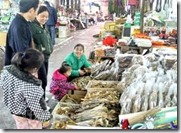This remark on the role of agriculture in the Vietnamese economy was made by Mr Dang Kim Son, Head of the Institute of Policy and Strategy for Agriculture and Rural Development (IPSARD) with reporter Anh Phuong.
Could you sketch out the overall picture of Vietnam’s agricultural development?
Currently, agriculture, forestry and fisheries continue to play an important role in the Vietnamese economy, contributing more than 20 percent to the country’s gross domestic product (GDP) and 28 percent to export turnover in 2010. Specifically, exports totalled US$19.15 billion, a record high, representing an increase of 22.6 percent over 2009 and an average rise of 17 percent per year in 2006 – 2010. To be precise, agricultural product export was estimated to bring in US$9.95 billion, up 24.22 percent over 2009; aquatic product export was valued US$4.94 billion, up 16.3 percent; and forest product export totalled US$3.36 billion, up 29.8 percent. In 2010, three products in these sectors surpassed export turnover of US$3 billion, including seafood, woodwork and rice; rubber fetched more than US$2 billion, and coffee and cashew nuts raked in more than US$1 billion each.
However, in the process of global market integration, Vietnam’s agriculture sector has not yet fully utilised its existing strength and capacity, the underlying reason for this weakness is market forecasting and market analysis. On a global scale, in 2010, we witnessed enormous changes in agricultural development strategies in most powerful agricultural exporters, particularly Thailand and the United States. Accordingly, the development strategies of these countries aim to ensure sustainable development, save domestic resources, downsize domestic agricultural production, and shift agriculture production investment to developing countries. Agricultural specialists in the countries are turning their eyes to Africa, considering it a good place for agricultural investment. This trend is also an option and lesson for Vietnamese agricultural policymakers to work out medium and long-term development plans.
High inflation has caused certain volatility in the domestic economy. How does this affect Vietnam’s agricultural development?
In fact, according to IPSARD specialists, the world economy will not fully recover and regain growth momentum until 2012. The Vietnamese economy is also affected. Global and domestic developments bring exposure to the risks and uncertainties of economic growth, which may distress production and business activities of Vietnamese agriculture. It is clear that the Vietnamese agricultural sector is encountering the fiercest-ever competition. Farmers and agricultural companies are facing tremendous difficulties and challenges like economic restructuring, high inflation, and economic downturn along with fiscal and monetary restraints, high volatility of international agricultural markets, threats of food crisis, climate change, weather shocks, animal diseases, and the high prices of agricultural inputs. However, from now till the end of 2011, the Government will still give priority to continued solutions to stabilise the macro economy in accordance with Decision 02/BCT. Hence, if the economy is seeing signs of positive change, it will be a key driving force for the agricultural sector to ease risks and volatility.
How did senior specialists from well-established institutions in the world assess Vietnamese agriculture when they attended the recent Vietnam Agricultural Outlook Conference 2011 held by IPSARD?
To acquire experience and knowledge from other countries and institutions with developed agriculture, many agriculture scientists and policymakers attended a meeting before this conference. Dr Steve Jaffee, Coordinator of the Rural Development Department at the World Bank (WB) in Vietnam, pointed out that the agricultural sector will face numerous risks and challenges in the present time and in the future.
Taking rice export as example, Vietnam has to date not outstripped Thailand, the world’s largest rice exporter. But, this will be the case if Vietnam knows how to combine and utilise its potential and advantages, like interconnecting all agricultural stakeholders, building value chains, and creating high added value. According to Dr Holger Matthey, an expert at the United Nations Food and Agriculture Organization (FAO), in the future, the world may suffer a serious food production slowdown on a global scale because climate change will dramatically impact soil conditions and farmers’ cultivation practices. Meanwhile, international scientists identify Vietnam as one of the five countries most affected by climate change. Hence, from now on, the Government of Vietnam should work out national programmes and targets to resist worsening climate change.
So, what will the Vietnamese agricultural sector focus on?
In the course of economic development, even in the most difficult time, agriculture is still the last end of the whole economy. Notwithstanding numerous difficulties and obstacles, this sector still maintains growth and stability in relation to other economic sectors. It is playing an increasingly important role in raising the country’s forex reserves. Typical examples include seafood, coffee, woodwork, rubber, pepper and dairy. Dang Le Nguyen Vu, General Director of Trung Nguyen Coffee Company, said the coffee industry currently brings in US$2 billion of revenues for the country, but Vietnam is confident it can earn US$20 billion from this sector if it receives proper investments. Many specialists share this standpoint: Vietnam can increase returns on agricultural production.


Deprecated: strpos(): Passing null to parameter #1 ($haystack) of type string is deprecated in /home/agriviek8Qv/agriviet.net/public_html/wp-includes/comment-template.php on line 2522